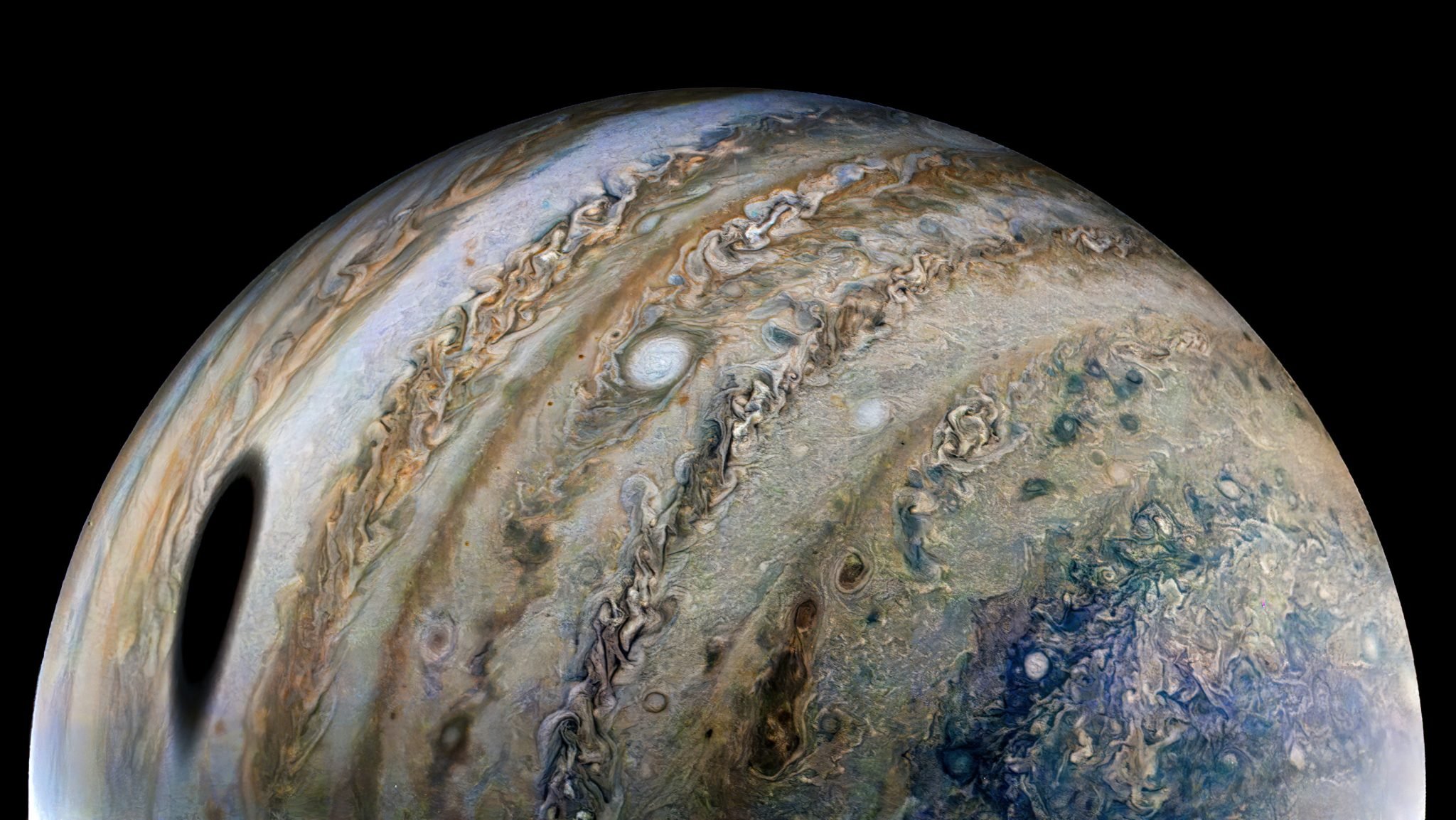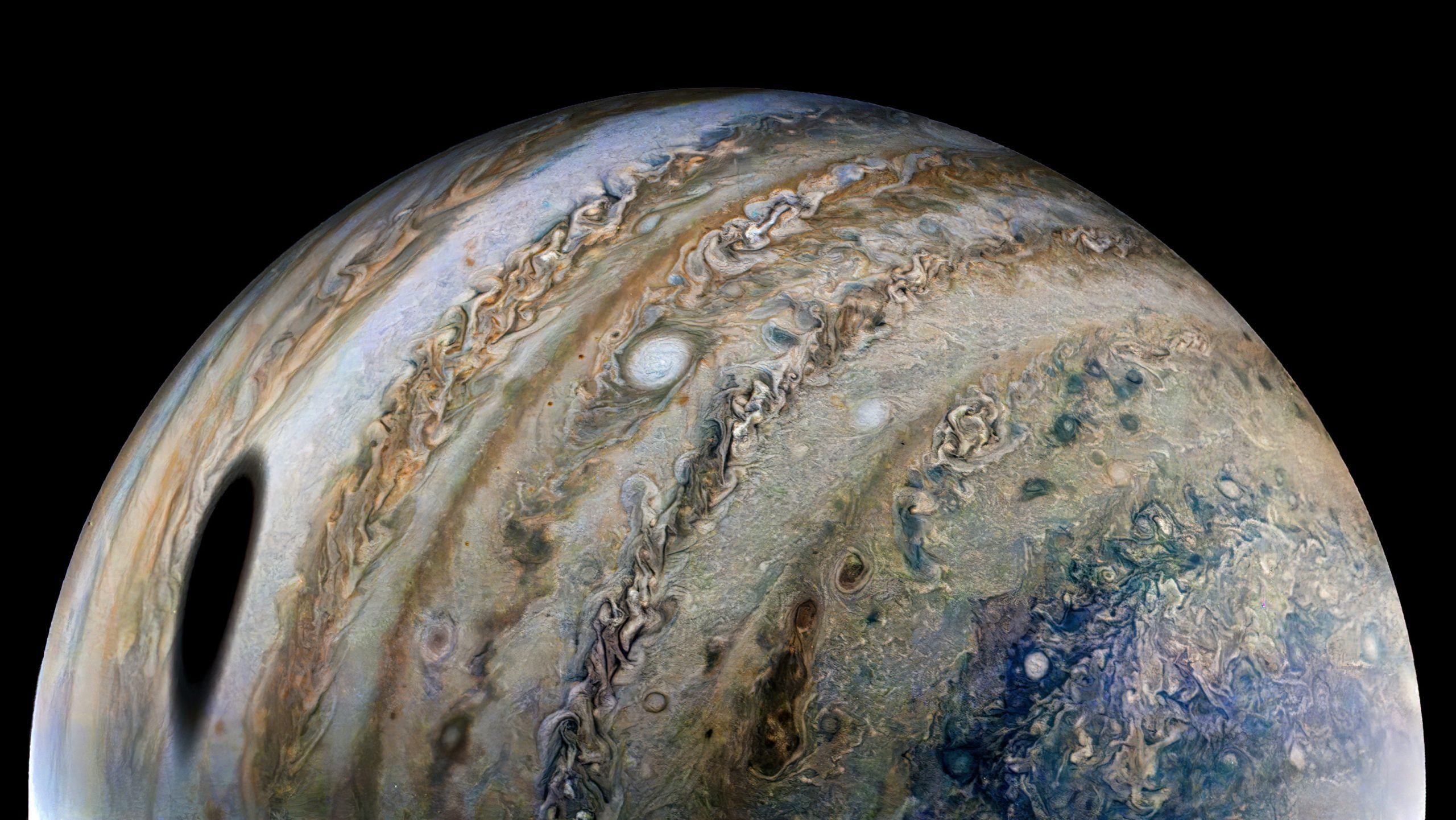
Фигура 1. Гражданинът учен Томас Тумопулос създаде това подобрено цветно изображение, използвайки необработени данни от инструмента JunoCam. По времето, когато е направено първоначалното изображение, космическият кораб Juno е бил на около 44 000 мили (71 000 км) над облачните върхове на Юпитер, на около 55 градуса южна ширина и 15 пъти по-близо от Ганимед, който обикаля около 666 000 мили (1,1 милиона км). )) далеч от Юпитер. Кредит: NASA/JPL-Caltech/SwRI/MSSS, Обработка на изображения от Томас Томопулос © CC BY
Jupiter during the mission’s 40th close pass by the giant planet on February 25, 2022. The large, dark shadow on the left side of the image was cast by Jupiter’s moon Ganymede.
Citizen scientist Thomas Thomopoulos created this enhanced-color image using raw data from the JunoCam instrument (Figure 1). At the time the raw image was taken, the Juno spacecraft was about 44,000 miles (71,000 kilometers) above Jupiter’s cloud tops, at a latitude of about 55 degrees south, and 15 times closer than Ganymede, which orbits about 666,000 miles (1.1 million kilometers) away from Jupiter.
An observer at Jupiter’s cloud tops within the oval shadow would experience a total eclipse of the Sun. Total eclipses are more common on Jupiter than Earth for several reasons. Jupiter has four major moons (Galilean satellites) that often pass between Jupiter and the Sun: in seven days, Ganymede transits once; Europa, twice; and Io, four times. And since Jupiter’s moons orbit in a plane close to Jupiter’s orbital plane, the moon shadows are often cast upon the planet.

Figure 2. Illustration of the approximate geometry of the Ganymede’s shadow projected onto a globe of Jupiter.
Credit: NASA/JPL-Caltech/SwRI/MSSS, Image processing by Brian Swift © CC BY
JunoCam captured this image from very close to Jupiter, making Ganymede’s shadow appear especially large. Figure 2, created by citizen scientist Brian Swift using JunoCam data, illustrates the approximate geometry of the visible area, projected onto a globe of Jupiter.
JunoCam’s raw images are available for the public to peruse and process into image products at https://missionjuno.swri.edu/junocam/processing.
Jupiter is the largest planet in the Solar System and the fifth planet from the Sun. It is a gas giant with a mass that is more than two and a half times that of all the other planets in the Solar System combined, but is only about one-thousandth the mass of the Sun. Jupiter, behind the Moon and Venus, is the third brightest natural object in the Earth’s night sky, and it has been noticed since prehistoric times. It was named after Jupiter, the Roman god and king of the gods.
Ganymede, a satellite of the planet Jupiter, is the largest and most massive of the Solar System’s moons. It is the ninth-biggest object in the Solar System (including the Sun) and the largest without a significant atmosphere. It has a diameter of 5,268 kilometers (3,273 miles), making it 26 percent larger by volume than Mercury, but it is only 45 percent as massive.

„Тотален фен на Twitter. Нежно очарователен почитател на бекона. Сертифициран специалист по интернет.“





More Stories
„Треска на ленивец“ или Оровирус навлезе в Съединените щати от Куба – ето какво трябва да знаете
Идентични следи от стъпки на динозаври открити на два континента
Най-мощният телескоп на Земята заснема изображения на черни дупки с безпрецедентни детайли